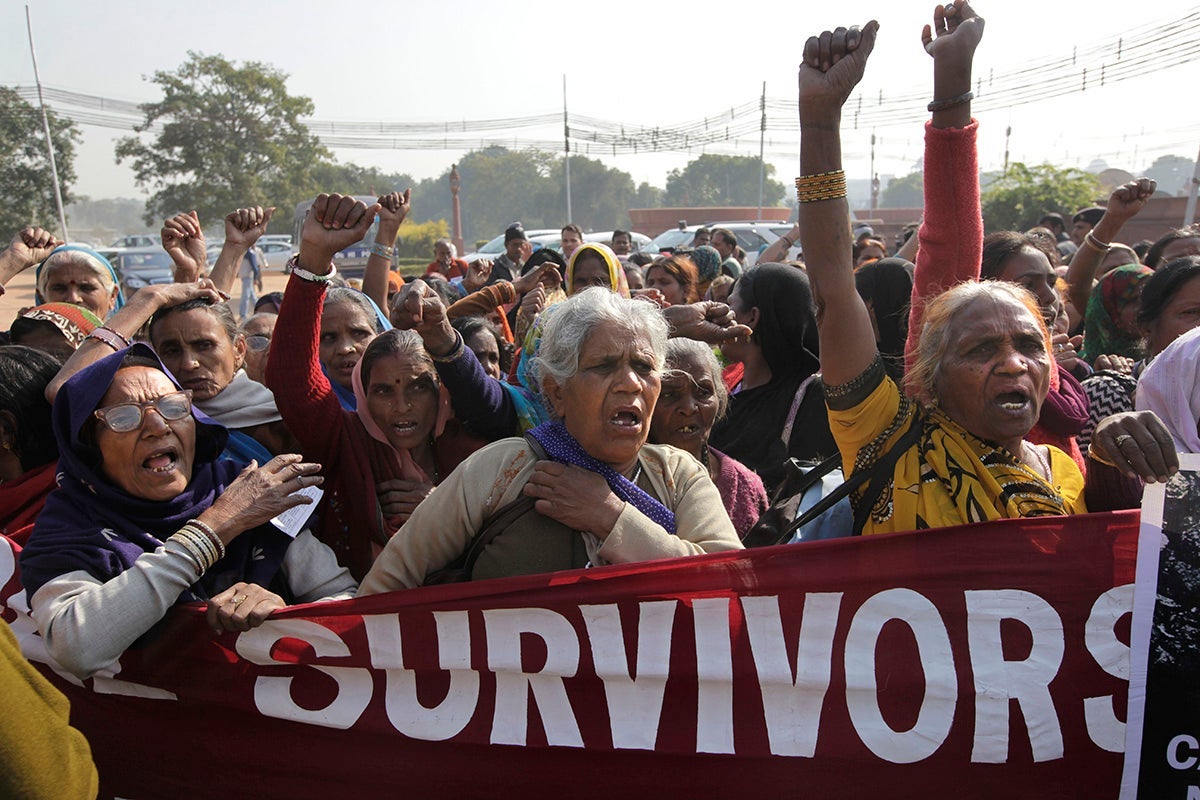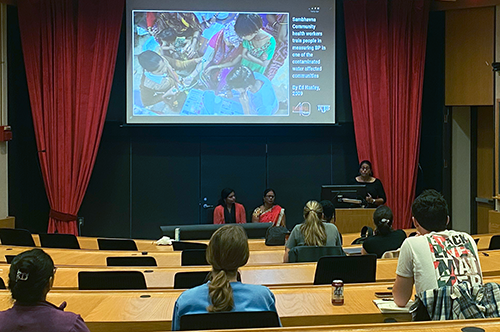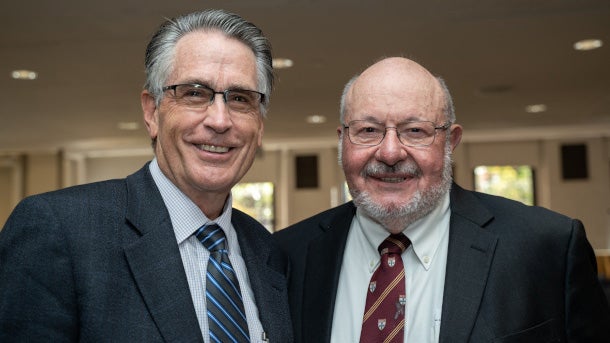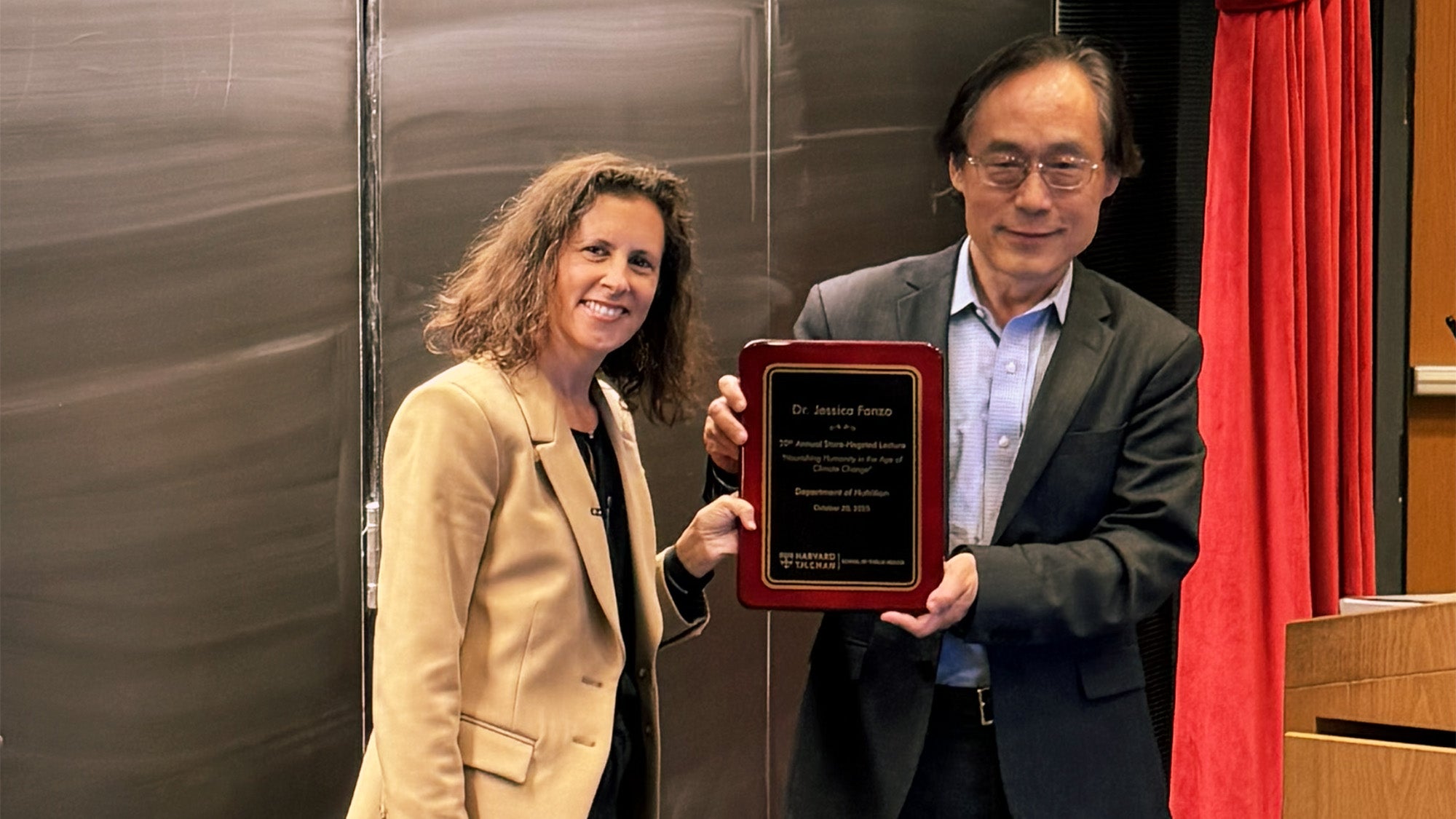40 years after Bhopal toxic gas leak, suffering continues

September 25, 2024 – On Dec. 3, 1984, there was a massive leak of a poisonous chemical called methyl isocyanate (MIC) from a Union Carbide pesticide plant in Bhopal, India. Thousands died and many thousands more were maimed and left with chronic health problems. The event has been called the worst industrial accident ever.
Survivors of the tragedy came to Harvard T.H. Chan School of Public Health on Sept. 23 as part of a 42-day tour across the U.S. to share their stories and to build support for activities related to the 40th anniversary. The event, held in Kresge G2 and sponsored by the Department of Environmental Health, featured Rachna Dhingra of the International Campaign for Justice in Bhopal, who served as interpreter, and two women who were young children at the time of the accident, Farhat Jahan and Bati Bai Rajak.
Although the disaster happened decades ago, survivors and their children are still dealing with the fallout, including health, environmental, and economic problems, said Dhingra. “The disaster still continues to kill and to disable a new generation,” she said. “And the perpetrators responsible for this continue to enjoy happy and rich lives. The corporations continue to do business as usual.”
She added, “The people in Bhopal are still seeking justice and accountability from the corporations that waged a genocide in their city 40 years ago.”
When the leak occurred, a cloud of toxic gas filled the streets and entered people’s homes. Many people ran out of their houses to try to get away from the gas, but the more they breathed in, the more the chemical filled their lungs, damaging their eyes, lungs, brain, and other bodily systems. In the first three days after the leak, 8,000 people were killed. Over time, it’s estimated that more than 22,000 people died from MIC exposure and more than half a million were maimed for life. Survivors have faced chronic health issues, three generations of birth defects, economic consequences, and ongoing groundwater contamination from unsafe disposal of poisonous wastes at the pesticide plant.

Jahan, who was five months old at the time of the leak, said that her mother recalled chaos in the streets, with people screaming “Run for your life!” Thick gas entered their house. Her parents ran. Her mother took her and her father took her siblings. They got separated in the confusion. Her mother found a park and stayed there with Jahan all night.
All initially survived, but the effects on the family were devastating. Her mother has pulmonary fibrosis. One sister, who was two years old at the time of the disaster, has chronic renal failure and is on dialysis several times each week. Another sister died of renal failure at age 24, leaving behind two daughters, one of whom was born with severe birth defects.
Rajak, who shared her story in a separate interview, was four years old at the time of the disaster. She remembers people running, her eyes burning, and coughing. Her family stayed in their house the night of the accident, covered with wet blankets—an uncle who worked at the Union Carbide factory had warned them to do so if a leak ever happened. “My father made sure that all three of my siblings were covered,” Rajak recalled. “Somehow the night passed. In the morning, when we went outside, there were so many people who were dead on the streets.”
Rajak’s family, like so many others, suffered severe health consequences, including vision and respiratory problems. Her parents couldn’t work; she left school in 8th grade to help support the family. Her older brother, whose vision had been impaired from the gas, was trying to make an electrical repair at age 15 but couldn’t see properly. He was electrocuted and died.
“We continue to bear the scars,” said Rajak.
Both Jahan and Rajak have gone on to help survivors in a variety of ways, including working at the Sambhavna Health Clinic in Bhopal, a free clinic created in 1996 by a group of survivors and activists to treat the generational health effects caused by the disaster; conducting research on groundwater contamination and ongoing health disparities among those exposed to the gas; and advocating for accountability for and cleanup of the disaster.
Dhingra spoke passionately about the need to bring the corporations responsible for the disaster to justice.
In the wake of the accident, Union Carbide tried to avoid responsibility, eventually reaching a settlement in 1989 of $470 million with the Indian government, which came out to roughly $500 per person—not nearly enough, Dhingra said. She argued that corporate negligence, including cost-cutting and safety lapses at the Bhopal plant, led to the accident. In 2001, Dow Chemical took over Union Carbide and has since denied responsibility to further compensate victims or to clean up the still-contaminated site because it didn’t own the company at the time the accident occurred.
In the meantime, survivors have continued to push for fair compensation for their losses as well as better access to health care. They’ve fought for justice in the courts, brought their complaints to international organizations such as the World Health Organization and United Nations, shared their stories widely, and organized demonstrations, sit-ins, hunger strikes, and marches.
“We want the world to know that the disaster is continuing,” Dhingra said in an interview. “It continues to cause chronic illnesses, disabling of the next generation, and an environmental disaster that keeps unfolding and finding new people to victimize and poison.” She added, “This was a corporate crime. … We don’t want this to be a story where the message is that the world’s worst industrial disaster resulted in corporations getting away with murder. We want the story to be about how this can be fixed, how justice can be given, how accountability can be realized.”
Photo: AP/Manish Swarup


